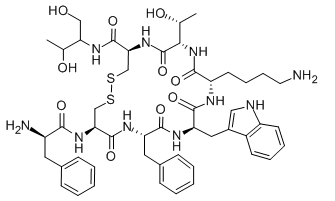2017-07-04
Octreotide, a long-acting structural derivative of somatostatins, is a synthetic peptide analog of somatostatin with the same pharmacologic effects. Octreotide is a cyclic octapeptide containing two D-configuration amino acids, with high binding affinity for somatostatin receptor (SSTR) 2 and 5, reduced affinity for SSTR3, and no affinity for SSTR1 and SSTR4. Its primary advantages over somatostatin are a longer half-life in the circulation, a higher potency, and good bioavailability after subcutaneous administration. The half-life of octreotide is 1-2 h compared with 2-3 minutes for somatostatin. Consequently, octreotide has largely supplanted somatostatin as a therapeutic agent for several diseases.
The discovery of somatostatin in 1973, for which Roger Guillemin and Andrew Schally shared the Nobel Prize, provided a new approach to investigating disease states associated with endocrine hypersecretion such as acromegaly and gastroenteropancreatic neuroendocrine tumors (GEP-NETs). In addition, octreotide can be used radiolabelling. The antineoplastic effects have been attributed to indirect inhibition of insulin-like growth factor-1 (IGF-1) through down regulation of growth hormone (GH) release, direct inhibition of tumor angiogenesis, anti-proliferation of tumor cells, and stimulation of the reticuloendothelial system (RES) by unknown mechanisms.

| CAT# | 10-101-26 |
| Product Name | Octreotide Acetate |
| CAS No. | 83150-76-9 |
| Sequence | H-D-Phe-Cys-Phe-D-Trp-Lys-Thr-Cys-L-threoninol acetate salt (Disulfide bond) |
| M.W/Mr. | 1019.28 |
| Molecular Formula | C49H66N10O10S2 |
The clinical use of Octreotide has been limited by the short elimination half-life (less than 2 h), which requires frequent daily subcutaneous (sc) or intravenous (iv) administration for acute indications or the use of an intramuscular sustained-release formulation for chronic therapy. Its therapeutic potential is also hindered by side effects, including cholesterol gallstones and hyperglycemia upon depression of insulin. Acute administration has also produced receptor desensitization or tolerance.
Octreotide and Gastroenteropancreatic Neuroendocrine Tumors
Gastroenteropancreatic neuroendocrine tumors (GEP-NETs), also known as carcinoids and islet cell tumors, are tumors derived from neuroendocrine cells that can occur anywhere along the gastrointestinal tract and comprise a heterogeneous family of neoplasms with a wide and complex spectrum of clinical behavior. Octreotide was among the first biotherapeutic agents used in the management of GEP-NETs and continues to be a mainstay of therapy today, although it is rarely curative.
Octreotide and Acromegaly
Acromegaly is a hormonal disorder that develops when pituitary gland produces too much growth hormone during adulthood. When this happens, bones increase in size, including those of your hands, feet and face. The pulsatile release of growth hormone (GH) by normal somatotroph cells is regulated by growth hormone releasing hormone (GHRH), which stimulates GH secretion, and somatostatin, which decreases secretion. There are two other classes of pharmaceutical agents that are very effective in patients with acromegaly. These include somatostatin analogs and GH receptor antagonists. Somatostatin analogs are given by injection. Octreotide and lanreotide are good choice.
Octreotide and Radiolabelling
Radiolabeled octreotide has been used successfully for imaging (neuroendocrine, endocrine, breast, small-cell lung, and prostate cancers) and more recently for targeted radiotherapy. It is also an effective agent for the control of therapy-induced diarrhea refractory to oral therapy.
References:
Yuan L. Reversible Lipidization of Peptide and Protein Drugs for Prolonging the Plasma Half-lives and Passive Liver Targeting[D]. University of Southern California, 2007.
Anthony L, Freda P U. From somatostatin to octreotide LAR: evolution of a somatostatin analogue[J]. Current medical research and opinion, 2009, 25(12): 2989-2999.